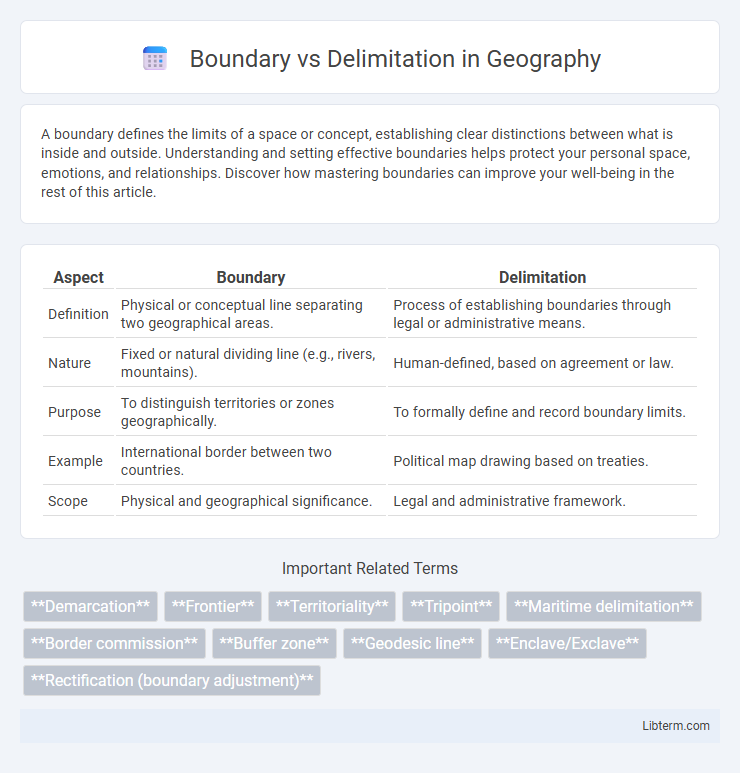A boundary defines the limits of a space or concept, establishing clear distinctions between what is inside and outside. Understanding and setting effective boundaries helps protect your personal space, emotions, and relationships. Discover how mastering boundaries can improve your well-being in the rest of this article.
Table of Comparison
| Aspect | Boundary | Delimitation |
|---|---|---|
| Definition | Physical or conceptual line separating two geographical areas. | Process of establishing boundaries through legal or administrative means. |
| Nature | Fixed or natural dividing line (e.g., rivers, mountains). | Human-defined, based on agreement or law. |
| Purpose | To distinguish territories or zones geographically. | To formally define and record boundary limits. |
| Example | International border between two countries. | Political map drawing based on treaties. |
| Scope | Physical and geographical significance. | Legal and administrative framework. |
Understanding Boundaries and Delimitations
Boundaries define the actual physical or conceptual limits of a geographical area, establishing clear territorial edges recognized by legal or social means. Delimitations refer to the precise process of drawing lines on maps or documents to formalize these boundaries based on specific criteria or agreements. Understanding boundaries involves grasping their real-world implications, while grasping delimitations requires analyzing how these boundaries are represented, negotiated, and enforced through legal and administrative frameworks.
Definition of Boundary
A boundary is a fixed geographical line that marks the official limits of a territory, separating one jurisdiction or region from another. It represents a legal and physical demarcation recognized by governments and international authorities. Unlike delimitation, which refers to the process of establishing or defining such lines, a boundary is the established and agreed-upon marker on maps or in the field.
Definition of Delimitation
Delimitation refers to the formal process of establishing and defining the exact line or limits of a territory, often marked on maps and agreed upon by involved parties or authorities. It serves as a preliminary step before demarcation, which involves physically marking the boundary on the ground. Delimitation clarifies territorial extents to prevent disputes and guide legal or administrative jurisdiction.
Key Differences Between Boundary and Delimitation
Boundaries refer to the fixed geographical lines that separate different political or administrative areas, while delimitations are the process or act of officially establishing those boundaries through legal or formal means. Boundaries are physical or conceptual markers, whereas delimitation involves detailed surveying, mapping, and legal documentation to define precise limits. The key difference lies in boundaries being the actual divisions, and delimitation being the method used to create and recognize those divisions.
Types of Boundaries in Geography
Types of boundaries in geography include natural boundaries, such as rivers, mountain ranges, and oceans, which are formed by physical landforms. Artificial boundaries, also known as cultural or political boundaries, are human-made lines often established through treaties or agreements, including latitude or longitude lines and walls. Delimitation marks the official process of legally defining these boundary lines on maps, distinguishing it from boundary demarcation, which involves physically marking the boundary on the terrain.
Methods of Delimitation
Methods of delimitation include natural features like rivers, mountains, and lakes that serve as clear geographic markers to distinguish territories. Artificial methods involve the use of latitude and longitude lines agreed upon through treaties or negotiations, often resulting in straight borders irrespective of natural geography. Arbitration and adjudication are legal methods where neutral parties resolve boundary disputes by interpreting historical claims, maps, and relevant international laws.
Historical Examples of Boundary and Delimitation
The distinction between boundary and delimitation is crucial in geopolitical contexts, where boundaries refer to the physical demarcations of territory, while delimitation involves the legal process of defining those boundaries on maps. Historical examples such as the Treaty of Tordesillas in 1494, which delimited Spanish and Portuguese territories, contrast with the tangible boundary lines drawn on the ground following the 1846 Oregon Treaty between the U.S. and British Canada. The Sykes-Picot Agreement of 1916 also illustrates delimitation by dividing Ottoman lands through agreement, leading to boundaries later established in the Middle East after World War I.
Importance in International Relations
Boundary defines the official, recognized border between sovereign states, establishing legal jurisdiction and preventing territorial disputes. Delimitation involves the negotiation process to agree on the exact position of these boundaries, crucial for maintaining peace and cooperation between neighboring countries. Effective boundary delimitation reduces conflicts, supports resource management, and promotes stable international relations.
Legal Implications of Boundary and Delimitation
Boundary refers to a legally recognized line that marks the physical limits of a territory, often established by treaties or historical agreements, carrying enforceable jurisdictional authority under international law. Delimitation is the process of legally defining and negotiating these boundaries, typically involving diplomatic dialogue to resolve disputes and clarify sovereignty. Both boundary and delimitation have critical legal implications for state sovereignty, resource rights, and geopolitical stability.
Challenges and Disputes in Defining Boundaries and Delimitations
Defining boundaries and delimitations often triggers challenges rooted in historical claims, geographic ambiguities, and political interests, leading to prolonged disputes between states. The lack of clear natural markers and differing interpretations of treaty language intensify conflicts, complicating international negotiations. Effective resolution requires precise cartographic methods and diplomatic dialogue to reconcile competing territorial assertions.
Boundary Infographic

 libterm.com
libterm.com